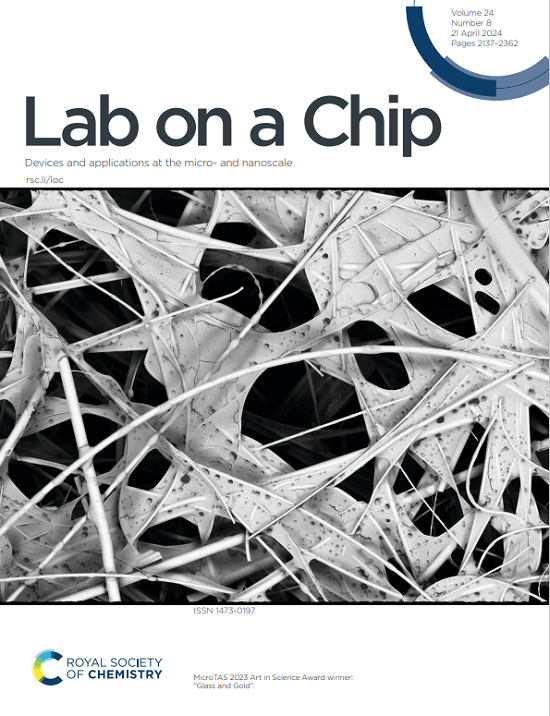基于3d打印模具的肠道芯片方法:一种具有成本效益和可访问的方法
IF 6.1
2区 工程技术
Q1 BIOCHEMICAL RESEARCH METHODS
引用次数: 0
摘要
肠道芯片(GoC)代表了一种颠覆性和有前途的技术,可以在生理相关背景下揭示肠道健康和病理的潜在机制。旨在采用这种方法的研究人员通常面临着购买昂贵的商业微流控芯片或在实验室从头开始构建定制设备之间的选择。然而,设计这样的微流体系统需要专门的技术技能。此外,制造用于芯片生产的主模具既昂贵又耗时,通常需要使用洁净室设施和先进的微加工设备。因此,由于这些技术和经济障碍,GoC技术在生物学和卫生研究实验室的广泛采用仍然有限。为了解决这些挑战,我们提出了3DP-μGut,这是一种使用标准桌面立体光刻(SLA) 3D打印机制造的开放获取,低成本的片上肠道平台。该设备设计简单,用户友好,使其可用于广泛的实验室。该方法已经过优化,可批量生产多个芯片,具有可重复性,适合于生物实验。此外,该设备经过改进,支持高分辨率共聚焦实时成像,并与各种微流体泵系统兼容,从基本到完全集成设置。作为概念的证明,Caco-2细胞在3DP-μGut中培养,成熟7天后,细胞形成了一个模仿体内结构的自组织3D上皮。最后,为了展示系统的通用性,引入植物乳杆菌和福氏志贺氏杆菌,分别进行共培养和感染试验。这项工作突出了3D打印作为经济实惠,可定制的GoC平台的强大推动者。本文章由计算机程序翻译,如有差异,请以英文原文为准。

Gut-on-chip methodology based on 3D-printed molds: a cost-effective and accessible approach
Gut-on-chips (GoC) represent a disruptive and promising technology to unravel the underlying mechanisms of gut health and pathology in physiologically relevant contexts. Researchers aiming to adopt this approach typically face a choice between purchasing expensive commercial microfluidic chips or building custom devices from scratch in their laboratories. However, designing such microfluidic systems requires specialized technical skills. Moreover, fabricating the master molds used in chip production is both costly and time-consuming, often requiring access to cleanroom facilities and advanced microfabrication equipment. Consequently, widespread adoption of GoC technology in biology and health research laboratories remains limited due to these technological and economic barriers. To address these challenges, we present the 3DP-μGut, an open-access, low-cost gut-on-chip platform fabricated using a standard desktop stereolithography (SLA) 3D printer. The device design is simple and user-friendly, making it accessible to a broad range of laboratories. The method has been optimized to allow the batch production of multiple chips with reproducible quality, suitable for biological experimentation. Furthermore, the device was improved to support high-resolution confocal live imaging and is compatible with various microfluidic pump systems, from basic to fully integrated setups. As a proof of concept, Caco-2 cells were cultured in the 3DP-μGut, and after 7 days of maturation, the cells formed a self-organized 3D epithelium mimicking in vivo structures. Finally, to showcase the system's versatility, Lactiplantibacillus plantarum and Shigella flexneri were introduced to demonstrate coculture and infection assays, respectively. This work highlights 3D printing as a powerful enabler of affordable, customizable GoC platforms.
求助全文
通过发布文献求助,成功后即可免费获取论文全文。
去求助
来源期刊

Lab on a Chip
工程技术-化学综合
CiteScore
11.10
自引率
8.20%
发文量
434
审稿时长
2.6 months
期刊介绍:
Lab on a Chip is the premiere journal that publishes cutting-edge research in the field of miniaturization. By their very nature, microfluidic/nanofluidic/miniaturized systems are at the intersection of disciplines, spanning fundamental research to high-end application, which is reflected by the broad readership of the journal. Lab on a Chip publishes two types of papers on original research: full-length research papers and communications. Papers should demonstrate innovations, which can come from technical advancements or applications addressing pressing needs in globally important areas. The journal also publishes Comments, Reviews, and Perspectives.
 求助内容:
求助内容: 应助结果提醒方式:
应助结果提醒方式:


